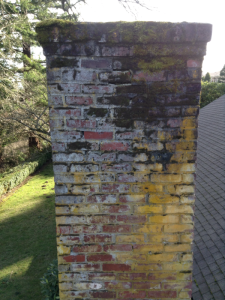Stains on the sides of your chimney structure can take away from the curb appeal of your entire home. And while chimney discoloration can make your chimney look unsightly, it may also indicate a deeper chimney problem. The following are four of the most common types of chimney discoloration, what causes them, and how it could be affecting your chimney system.
Black and brown stains
Black and dark brown areas of discoloration on the inside and outside of the chimney are typically caused by soot. Soot stains are very common on older chimneys as well as those that have not been properly maintained.
Interior soot stains, especially those on the masonry directly above the firebox, are usually purely cosmetic. This kind of discoloration is most often caused by a lack of regular chimney cleaning, repeated use of green or unseasoned firewood, or a fire that was too large or otherwise out of control.
When found on the top and sides of the chimney, soot stains are typically the result of an excess of creosote in the chimney. Although creosote is naturally produced in wood burning fires, it can be made worse by allowing fires to smolder, burning green wood, or having a flue that is improperly sized. Because creosote is extremely flammable, it is important to have your chimney swept regularly – especially if black or dark brown discoloration appears.
Gas fireplaces and heating appliances should never have soot staining on the chimney. If this kind of staining is spotted on the chimney of a gas fireplace, it is important to stop using the fireplace and call a chimney sweep. Soot staining on gas fireplaces often indicates a malfunction or leak; this could lead to a buildup of dangerous gasses like carbon monoxide in your home.
Green stains
While it may be difficult to distinguish a dark brown stain from a dark green one, they have very different causes. Dark green discoloration n a chimney can be caused by algae and mold growth. This typically occurs when too much water repeatedly comes in contact with one area of the chimney, such as when a sprinkler repeatedly hits the same spot.
Red rust stains
Rust stains are commonly seen on homes with prefabricated or metal chimneys and can come in a rainbow of reds, browns, and oranges. This kind of discoloration is a sign that the metal chimney chase cover has begun to rust. If this type of discoloration is discovered, a chimney sweep should evaluate the condition of the chase cover before it is replaced to see if there has been any water damage to the rest of the fireplace and chimney system.
White stains
Powdery white stains on a chimney structure are a phenomenon known as efflorescence. Efflorescence a buildup of the mineral salt that gets left behind as ground and rain water evaporates. Exterior efflorescence is usually benign and can be caused by a number of sources including rain and sprinklers. However, if efflorescence appears on interior masonry, it is almost always a sign of an interior chimney leak.
Chimney staining and discoloration can be a black mark on your home’s beautiful exterior – literally. To diagnose the cause of your chimney discoloration and keep it from coming back, call the experts at Pristine Sweeps today.

